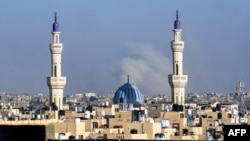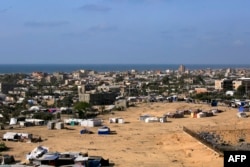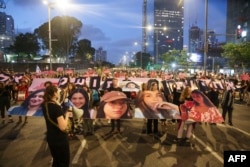Israeli forces pressed their military operation against Hamas throughout Gaza on Saturday as the prospect of a new round of mediated negotiations grew.
The decision for new negotiations was made after the head of Israel's Mossad intelligence agency met with CIA chief William Burns and Qatari Prime Minister Mohammed bin Abdulrahman bin Jassim Al Thani, according to an official on Saturday who declined to be identified because of the sensitivity of the situation.
"At the end of the meeting, it was decided that in the coming week negotiations will open based on new proposals led by the mediators, Egypt and Qatar and with active U.S. involvement," said the source, who spoke with Reuters.
Hamas later told Reuters that "there is no date" for the talks to resume.
There has been a stalemate in peace talks between the two enemies, with Israel demanding the release of the hostages held by Hamas, and Hamas calling for the release of Palestinian prisoners and an end of the war in Gaza.
Fighting across Gaza
More than 40 people were killed in the enclave Saturday, according to the Gaza Health Ministry, which does not distinguish between civilian and combatant casualties.
Israeli forces pushed deep into Jabalia, north of Gaza city, and said they "eliminated dozens of terrorists in close-quarter combat and aerial strikes." But residents and civil emergency services in the area said Israeli tanks rolled in, destroying dozens of houses, shops, and roads.
Hamas, which governs Gaza, and the smaller armed group Islamic Jihad said their fighters had fired anti-tank rockets and mortar bombs at Israeli troops in the north of the enclave.
In the southern city of Rafah, Israel’s military operations continue, despite the ruling by the U.N. International Court of Justice that Israel should "immediately halt its military offensive" in Rafah. Israel says its goal in Rafah is to eliminate Hamas cells embedded there. It also said that some of its hostages are being held there.
On Friday, Israel said it had found weapons stashes, destroyed part of a tunnel system and killed militants. Most of the fighting is reportedly in along the city’s southern edge and eastern districts, according to Reuters.
One Rafah resident, who asked not to be named, said the Israeli military is assaulting the city indiscriminately.
"The occupation forces keep the city under bombing, not only east where they invaded but at the center and the western sides, they want to scare people to leave the whole city," said the resident.
The city has become a refuge for hundreds of thousands of Gazans fleeing fighting elsewhere in the enclave. After Rafah became a target as well, hundreds of thousands of Palestinians fled the city.
Since Hamas launched a terror attack October 7 on Israel, killing about 1,200 people and taking roughly 250 hostages, Israel has embarked on an offensive to eliminate Hamas from Gaza. In recent weeks, Israel says its forces have killed 30,000 people, the majority of them combatants. The Hamas-run Gaza health ministry says 35,000 people have died, most of them women and children, but does not estimate how many of the dead were combatants.
The United States, Israel’s main ally, has opposed Israel’s invasion of Rafah, where more than a million refugees were sheltering from clashes elsewhere. Some 900,000 have since fled Rafah, according to the Israel military.
Gaza pier
Four U.S. Army vessels ran aground Saturday in heavy seas off the coast of Gaza. The four vessels were there to support the temporary pier, U.S. Central Command said Saturday in a statement.
"The vessels broke free from their moorings and two vessels are now anchored on the beach near the pier. The third and fourth vessels are beached on the coast of Israel near Ashkelon," the statement said.
"No U.S. personnel will enter Gaza. No injuries have been reported and the pier remains fully functional," it continued, adding that the Israeli navy is assisting with recovering the vessels.
The statement also said that more than 1,000 metric tons of aid had been delivered via the pier since Friday, more than 900 metric tons of it were distributed to the U.N. warehouse.
Some information used in this report was provided by The Associated Press, Agence France-Presse and Reuters.











